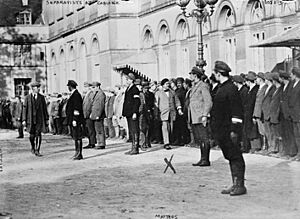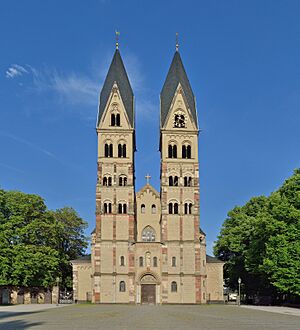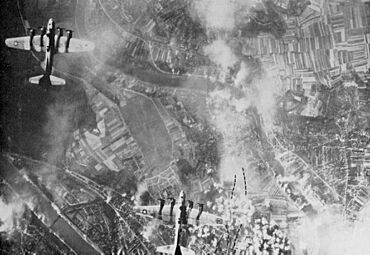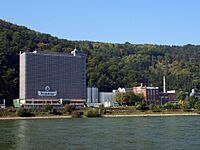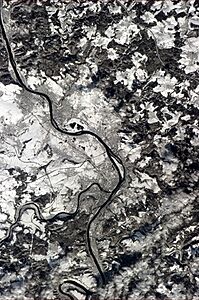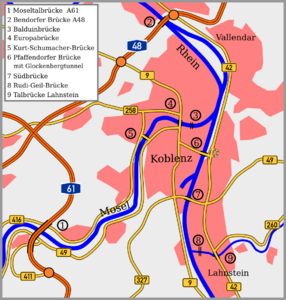Koblenz facts for kids
Quick facts for kids
Koblenz
|
|||
|---|---|---|---|
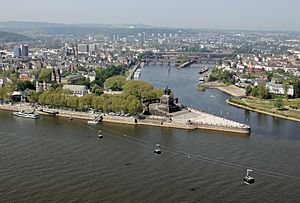
View of the Deutsches Eck and Koblenz Old Town
|
|||
|
|||
| Country | Germany | ||
| State | Rhineland-Palatinate | ||
| District | Urban district | ||
| Elevation | 64.7 m (212.3 ft) | ||
| Population
(2022-12-31)
|
|||
| • Total | 115,268 | ||
| Time zone | CET/CEST (UTC+1/+2) | ||
| Postal codes |
56001–56077
|
||
| Dialling codes | 0261 | ||
| Vehicle registration | KO | ||
| Website | koblenz.de | ||
Koblenz is a cool German city located where two big rivers meet: the Rhine and the Moselle. Its name actually comes from a Latin word meaning "at the confluence," which is a fancy way of saying "where rivers join."
This city has a long history, starting as a Roman military camp around 8 BC. Today, the spot where the rivers meet is called the "German Corner." It's a famous landmark with a large statue of Emperor William I, symbolizing the unification of Germany. Koblenz celebrated its 2,000th birthday in 1992!
With about 112,000 people, Koblenz is the third-largest city in the German state of Rhineland-Palatinate. It's nestled in a valley between hills and has great connections by train and highway.
Contents
Exploring Koblenz: A Historic German City
How Koblenz Got Its Name
Over time, the city's name has been spelled in different ways, like Covelenz and Coblenz. In the local dialect, people still say "Kowelenz," which is similar to the oldest spellings.
A Journey Through Koblenz's Past
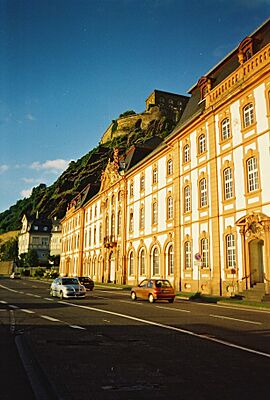
Ancient Times: Romans and Forts
Around 1000 BC, people built early forts on the Festung Ehrenbreitstein hill, across the Rhine River. Later, in 55 BC, Julius Caesar and his Roman soldiers reached the Rhine. They even built a bridge nearby.
About 9 BC, the Romans set up a military post called Castellum apud Confluentes in Koblenz. You can still see parts of a large Roman bridge built in 49 AD. The Romans also built two forts to protect their bridge.
The Middle Ages: Kings, Treaties, and Knights
After the Western Roman Empire fell, the Franks took over Koblenz. It became an important royal city. In 843, a famous agreement called the Treaty of Verdun was discussed here. This treaty divided Charlemagne's empire, and Koblenz became part of a region called Lotharingia.
In 925, Koblenz joined the eastern German Kingdom, which later became the Holy Roman Empire. In 1018, the city was given to the archbishop-elector of Trier, who ruled it for centuries. In 1216, the Teutonic Knights received land at the river confluence, which is now the "Deutsches Eck."
Between 1249 and 1254, new walls were built around Koblenz. The archbishops also made the Ehrenbreitstein Fortress stronger to protect the city.
French Revolution Era: A Place for Refugees
When the French Revolution began in 1789, many French nobles and royal supporters fled to Koblenz. They hoped to gather support and armies to go back to France and restore the old ways.
In 1792, a large army, including Prussians and Austrians, marched towards Koblenz. They threatened to destroy any towns that resisted. Luckily, bad weather and difficult roads stopped them, and Koblenz was saved.
Later, in 1794, the French Revolutionary army captured Koblenz. After a treaty in 1801, Koblenz became the capital of a new French department.
Modern History: Prussia, Wars, and Reunification
In 1814, Russian troops occupied Koblenz. Then, in 1815, the Congress of Vienna decided that Koblenz would become part of Prussia. It became an important administrative center for the Prussian Rhine Province.
After World War I, French forces occupied the area again. During World War II, Koblenz was heavily bombed, like many other cities. It was rebuilt after the war. From 1947 to 1950, it even served as the capital of Rhineland-Palatinate.
In 2002, the beautiful Rhine Gorge, with Koblenz at its northern end, was named a World Heritage Site.
Main Sights in Koblenz
Fortifications and City Layout
Koblenz has strong defenses, including forts on the hills to the west and the impressive Ehrenbreitstein Fortress across the Rhine. The old city used to be shaped like a triangle, with rivers on two sides and walls on the third. These walls were removed in 1890, allowing the city to grow.
Today, the city has an Altstadt (old city) and a Neustadt (new city). The old city has narrow streets, while the new city has wider streets and a nice view along the Rhine.
Other Interesting Places
In the older part of Koblenz, you can find several historic buildings. One important one is the Basilica of St. Castor, a church with four towers. It was founded in 836, and the current building was finished in 1208. In front of it, there's a fountain built by the French in 1812.
Another notable church is the Liebfrauenkirche, with tall Romanesque towers. You can also see the old castle of the electors of Trier, which now holds a city art gallery. The family home of Prince Metternich, a famous Austrian statesman, is also here.
The former Jesuit College, a beautiful Baroque building, is now the City Hall. Nearby, you can visit Lahneck Castle near Lahnstein.
- Sightings
The Electoral Palace
In the newer part of Koblenz is the Electoral Palace (Residenzschloss). It was built between 1778 and 1786 by Clemens Wenceslaus of Saxony, the last elector of Trier. Today, the palace is a museum. It has beautiful gardens along the Rhine, where you can find memorials to famous people.
William I Monument at Deutsches Eck
The Teutonic Knights had their headquarters at the meeting point of the Rhine and Mosel rivers, which became known as the German Corner (Deutsches Eck).
In 1897, a huge monument to German Emperor William I of Germany was unveiled here. It features a 14-meter (46-foot) tall statue of the emperor on horseback. This monument became a symbol of the newly unified German Empire.
During World War II, the statue was destroyed. In 1953, the monument was rededicated to represent German reunification. Signs of the German states were added. In 1993, a copy of the original statue was placed back on the monument.
City Growth: Incorporated Villages
Over the years, Koblenz grew by adding nearby villages. This helped the city expand its area and population.
Climate in Koblenz
Koblenz has a mild climate. This means that plants like fig trees, olive trees, and palm trees can grow in the area, which is quite special for Germany!
Economy: What Koblenz Makes and Does
Koblenz is important for the wine trade from the Mosel and Rhine regions. It also exports a lot of mineral water. The city manufactures things like car parts, paper, and machinery. It's also home to the Königsbacher brewery, which has been making beer since the 17th century.
Koblenz is a key transport hub in the region. It's also home to important military headquarters, like the Joint Medical Service of the German Army. Big companies like Amazon and Canyon Bicycles also have facilities or headquarters near Koblenz.
Getting Around: Transport in Koblenz
Roads and Bridges
Koblenz is well-connected by major highways, including the A 61 and A 48. Many bridges cross the Rhine and Moselle rivers, making it easy to travel around. Some famous bridges include the Pfaffendorf Bridge over the Rhine and the Balduin Bridge over the Moselle.
Railways
Koblenz Hauptbahnhof (main station) is a major train stop. You can catch high-speed trains here that connect to other big German cities like Bonn and Mainz. Koblenz is also the starting point for train lines that go to Trier, Luxembourg, and other towns.
- Maps
-
Koblenz, as seen from the International Space Station
Education in Koblenz
Koblenz is a place where you can learn a lot! It has a campus of the University of Koblenz and the Koblenz University of Applied Sciences, offering many study programs.
International Friends: Twin Towns
Koblenz has "twin city" relationships with several cities around the world. This means they share cultural exchanges and friendly ties. Some of its twin cities include:
- Nevers, France (since 1963)
- Haringey, United Kingdom (since 1969)
- Norwich, United Kingdom (since 1978)
- Maastricht, Netherlands (since 1981)
- Novara, Italy (since 1991)
- Austin, United States (since 1992)
- Petah Tikva, Israel (since 2000)
- Varaždin, Croatia (since 2007)
Famous People from Koblenz
Many interesting people were born or lived in Koblenz:
- Thomas Anders (born 1963), a singer from the famous band Modern Talking.
- Max von Laue (1879–1960), a physicist who won the Nobel Prize in Physics in 1914.
- Klemens von Metternich (1773–1859), an important Austrian diplomat and statesman.
- Tobias Lütke (born 1981), the founder and CEO of Shopify, a big e-commerce company.
- Bodo Illgner (born 1967), a well-known soccer player.
See also
 In Spanish: Coblenza para niños
In Spanish: Coblenza para niños





